
Most advanced equalizers Archives

most advanced equalizers Archives
home
text
The “Perfect” EQ Settings: Unmasking the EQ
As someone who is quite an audiophile – who just doesn’t enjoy listening to music, but also plays several instruments – I was surprised when I stumbled upon an article at Max OS X Hints claiming what the “Perfect” EQ settings are.
What the article failed to realize is that such settings won’t provide great sound at all, instead they’ll actually reduce the quality, and cause something known as clipping – thus decreasing your total listening experience.
Quite frankly, the only reason you think you need such settings is you’re either using subpar headphones, don’t have a high-quality speaker setup, or just plain don’t care. But seriously – why would you do that to yourself!!?
This is what Mac OS X Hints shows as the “perfect” setting:
How absurd! They’ve got to be kidding me..
So you ask, “What really is the best EQ setting?”
Well, you have to understand the EQ is a piece of software which increases or decreases a particular frequency – the optimal EQ setting should always be “Flat.” You don’t really want to distort your music, plus you have to remember – when you change the EQ you’re no longer listening to the music as recorded on the master recording.
But – if you want to get a little more out of your sound, let me explain to you what all those numbers and sliders on your EQ really mean, and do..
All those numbers and sliders – they correspond to different audio frequencies and wavelenghts (Duuuh! Soo?!).
Well, this is what they mean:
- 32 Hz: This is the lowest frequency selection on the EQ. This sits in the lowest of low bass frequencies. This is where subwoofer information resides in songs (such as kick drums and bass instruments). A majority of speaker systems on the market can’t even reproduce this frequency – the only way you can hear this frequency is with a good dedicated amplifier with a high-quality subwoofer, or with some premium IEMs.
- 64 Hz: This second bass frequency starts to become audible on decent speakers or subwoofers. Again, mostly bass drums and bass instruments will reside in this region.
- 125 Hz: Many small speakers, such as in your laptop, can just about handle this frequency for bass information. In other words, if you turn it up on most systems, you’ll hear more bottom/bass in your mix.
- 250 Hz: This is still considered low-end, but more of the “woofy” sound of bass and drum sounds. Guitars and pianos will have a large amount of low end in this frequency range.
- 500 Hz: Now were approaching midrange frequencies, but still some of the low end of vocals and the mids of bass instruments sit here in a mix.
- 1K: This is now low midrange of most instruments such as guitars, pianos, snare drums, etc.
- 2K: The 2K frequency can boost or cut the “nasal” sound of your music, in the range your voice makes when you hold your nose and talk.
- 4K: 4K is the upper mid range that many electric guitars sit in, as well as a large portion of many instruments.
- 8K: This is getting into the high end, where the majority of cymbals and hi-hats are, as well as upper range of synths, pianos and guitars. Many vocals have a lot of information in this range.
- 16K: Theoretically, us humans can hear just above 20K, so this is true high end. If you crank this up, your songs will get ‘sizzly’. This is the top of high end on the iTunes equalizer.
By the way, I hope you know – you’ll never get that “perfect” sound you want on a lot of speaker and stereo configurations, on your laptop, or even on your desktop – so just stop trying!
You can only get that “perfect” sound with a high-quality speaker setup (one which has its own dedicated amps for its speakers/tweeters, and the subwoofer), or you can also get that “perfect” sound with a set of premium IEMs.
And with these, if you feel like the sound is empty, and/or you don’t like having your EQ set as “Flat” – you can adjust your settings slightly, to be “engineered."
So, if you want to perfectly engineer your sound to be just right – I have researched, tested, and tried everything on all sorts of equipment, with all varieties of music.
In the end, this turned out to be the true “Perfect” EQ setting:
Yes, even with this setting – you will have PLENTY of bass (on most decent IEMs, and all premium IEMs, as well as all high-quality sound systems).
But if that configuration just isn’t enough for you, you can try an alternate ”Boosted“ EQ – to boost both the bass and treble while raising the mids slightly, which can be seen below:
NOTE: If you’re a Mac OS X user, you can add/install the above two EQ’s by downloading the file ”EQs-by-iamziyad.dmg.“ Also, make sure you have
Sound EnhancerandSound Checkdisabled in iTunes.
I have found either one of the two above settings to be optimal while using iTunes with premium IEMs, and also with high-quality audio equipment.
However, when it comes to an iPod – I recommend you to keep the EQ on ”Flat“ or ”Off.“ Also, if you’re not using a high-quality sound system, or if you’re using a laptop, those cheap Apple iPod headphones, etc. – I suggest you do the same. You don’t want to have your music clip while listening to it, or worse – risk blowing out your speakers!
Ultimately, you can only do so much with software – in the end, it’s the hardware which truly makes the difference!
If you really want to hear your music – my kind suggestion to you is to go out and buy yourself a pair of IEMs, if you already don’t own a pair.
But don’t worry – you don’t have a fat wallet to have ”phat“ sound.
So now you wonder; ”What are the best IEMs?“ and "How much do an entry-level, and premium pair of IEMs cost?” and, “Which kind is the best for me?”
Well, that’s simple. Depending on the quality you’re after, you can get IEMs that drop into various price, and quality ranges which go from entry-level to medium quality at $20 to $75; premium to professional quality at $75 to $200; and high-performance professional quality that runs upwards of $500 to $1500.
So let me break it down for you..
A decent pair of IEMs,which would be the equivalent of owning a ‘Honda’, a 'Toyota’, or a 'Nissan’ – are available rather affordably, costing anywhere between $20 to $75 (such as the Denon AH-C252K, Klipsch S2, Klipsch S4, Sony MDR-EX 81LP, and the Maximo iMetal iM590). Entry-level to medium IEMs usually deliver audio quality that would be described as “sounding good” to the untrained ear, and are relatively comfortable – but most of them don’t have the same build quality as their more expensive counterparts, thus usually not lasting as long.
To be straight-forward and honest – if you really want the most for your money, and the best out of your music then I recommend going for a pair of premium IEMs which will run you anywhere between $75 and $200.
Such IEMs would be like owning a luxury, and performance model of a 'BMW’, 'Mercedes’, or a 'Bentley’ in the world of cars.
One of the best parts about premium IEMs is you get amazing clarity, that perfect bass you’re always after, clear mids, and a tuned treble. Another absolutely wonderful part about them is you can also listen to your music at relatively low volumes and still hear everything – as almost all premium IEMs offer excellent noise isolation technology. Aside from that most companies, usually provide a no-questions-asked extended warranty (as a commitment to stand beside the build quality of their product).
In the $75 to $200 range we have only some of the best. In this class, you can get some amazing quality premium IEMs (such as the V-Moda Remix Remote, Tour Beats by Dre, Denon AH-C700, Atrio M5, Shure E3c, and the Etymotics’ ER-6i). Premium to professional IEMs provide excellent audio quality with full bass and treble coverage, without “muddying” the mids, all while still being the most comfortable.
Although, if you’re feeling really brave and want to go all out and splurge ($500 to $1500) – you can get a pair of what many audiophiles, and music artists would consider to be the 'Bugatti Veyron’ or the 'McLaren F1’ of IEMS which can have as many as 6 speakers per ear, and fit your ears precisely – as they’re custom-made and molded from your own ears (available from Ultimate Ears and Livewire).
I bet you’re saying, “Ooh, woooow!” right now – that’s what I said the first time I saw them too!
I know, those custom-made IEMs are just ridiculously expensive! You honestly don’t need anything like that unless you’re going to be standing on stage in front of 250,000 screaming and roaring fans – so just forgetta 'bout it!
Just trust me, with a properly configured EQ and a good pair of IEMs..
You will rediscover all of your music – you will enjoy it in peace. You will hear things you have never heard or noticed before.
You won’t just enjoy your music more, but you will forget about even using the EQ – you will be shocked by how much you will be able to hear every beat, every frequency, all that bass, and all that treble!
The best part is, you will be able to do this all without even turning up the volume that high, or playing with your EQ – distorting the sound.
Instead you’ll be immersed in a truly beautiful listening experience.
Bottom Line: If want to enjoy your music – do it the right way!
blog comments powered by Disquslikeatolarboss liked this
internationalorange liked this
koolinus liked this
bigmelwalter reblogged this from ziyadnazem
bigmelwalter liked this
 vvla liked this
vvla liked this vixiana liked this
easyexit liked this
carsian liked this
 simple-mindedpleasures liked this
simple-mindedpleasures liked this railly-r liked this
bwdphoto reblogged this from ziyadnazem
009px liked this
 alfestone reblogged this from ziyadnazem
alfestone reblogged this from ziyadnazem r3volutionarythoughts liked this
r3volutionarythoughts liked this seetheuntold liked this
bwdphoto liked this
redwerkz liked this
 animenculture liked this
animenculture liked this  bogthing liked this
bogthing liked this jinqle liked this
wingshark liked this
fuzzyankles reblogged this from ziyadnazem
teatb liked this
lesbieee reblogged this from ziyadnazem
borgonaut liked this
pigletdiary liked this
thereforereblog liked this
missng liked this
jdwasabi liked this
thecrunkstables liked this
taughtmetobloom liked this
sandiego619ca liked this
seven72 liked this
johnaaay-blog liked this
thebiopsy liked this
mrtoutlemonde liked this
higurashi-moratorium liked this
athousandwatts reblogged this from ziyadnazem
athousandwatts liked this
ziyadnazem posted this
- Show more notesLoading...
 92 notes
92 notes 10 years ago
10 years ago IEMsaudioearphonesitunesmusicrantsthe perfect EQthe truth
IEMsaudioearphonesitunesmusicrantsthe perfect EQthe truthBoom: Music Player, Bass Booster and Equalizer
Boom is a powerful Music Player with a magical 3D surround sound, powerful Bass and an advanced Equalizer
• Immerse yourself in your favorite music with 3D surround sound experience!
• Use handcrafted equaliser presets for every genre or create your own custom preset!
• Listen to your favourite tracks in Spotify and TIDAL or your own music collection on device or on cloud (Google Drive & Dropbox)
• Enjoy over 20,000 Radio channels and Podcasts
• Get immersive surround sound experience on ANY headphones!
• Create your own Equalizer setting using the 16-band or 8-Band Equalizer
• Play Hi-Res audio revealing extraordinary audio details in 3D mode
• Enjoy your drive with magical 3D Music experience with Android Auto support
Here’s Boom, a Music app worthy of being your default Music Player!
Magical 3D Surround Sound
Boom uses a patent-pending 3D audio technology to deliver the most realistic and immersive music experience on ANY headsets! It extracts spatial cues from your music to render them in three-dimensional clarity for an extremely intense listening experience.
Stream Spotify and TIDAL with Boom
You can stream all your music from Spotify and TIDAL through Boom with all the Boom effects! Experience music with unbeatable quality, anytime, anywhere!
Note: Spotify and TIDAL requires premium subscription plans of the respective services.
20,000+ Radio and 20,000+ Podcast Stations Worldwide
Boom Android gives you the access to over 20,000 local and international radio stations and 20,000+ podcast stations across 120 countries! Tune in to your favorite station for free, whenever and wherever you want!
Play music from your device or Cloud
Boom lets you stream or download your music directly from your Dropbox and Google Drive with all the effects.
Handcrafted Equalizer Presets
Music buffs, be delighted to know that Boom comes equipped with 22-handcrafted Equalizer presets for all popular genres of music. Select the one based on your mood and taste, and get high on your music with more colors.
Custom Equalizer settings
Create your own Equalizer setting using the 8-Band Equalizer
Hi-Res Audio Support
Play your Hi-Res audio files in 3D. Supported formats include AIFF, FLAC, ALAC, WAV, DSF
System-Wide Audio FX
Apply custom-tuned EQ presets, Virtualiser and Loudness effects, system-wide. Now listen to Netflix, Youtube, Amazon Prime, Deezer and much more with Boom Effects
Boom Android has a sleek and easy-to-use interface that is simple and intuitive to use. So, whether the beat gets dropped or the tempo amplifies, with BOOM you don’t have to worry! You can get high on your music always and FEEL YOUR MUSIC like you’ve never had! This pretty yet mighty music player brings you a whole new audio quality that the Android users have never experienced!
Be a part of the audio revolution and join us to change the way you listen!
Don’t forget to leave your positive reviews and ratings to further encourage us :)
Like us, follow us and share your experience with Boom on social media.
Twitter - https://twitter.com/boomapp
Facebook - https://www.facebook.com/boomapp
Instagram - https://www.instagram.com/boomaudioapp
Tag: equalizers
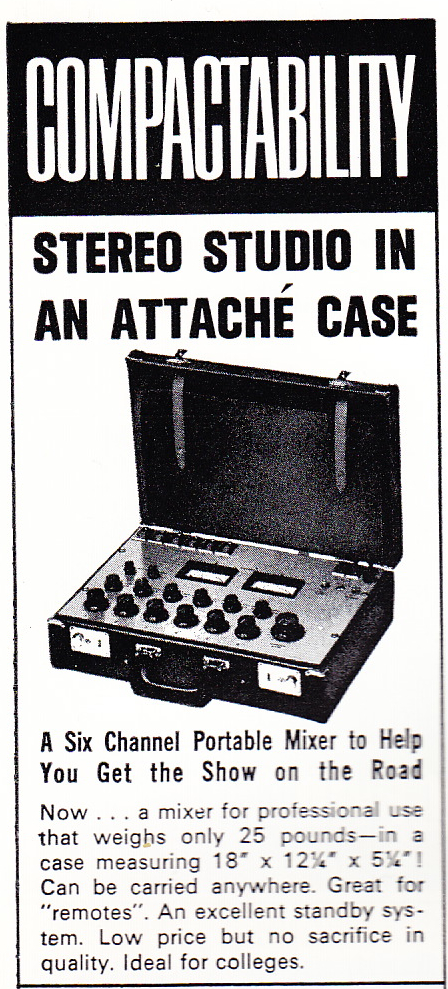 Above: Gately’s Stereo Briefcase Mixer circa 1970.
Above: Gately’s Stereo Briefcase Mixer circa 1970.
Gately Electronics was a Pennsylvania-based pro-audio manufacturing and importation/ distribution operation which seems to have operated between 1968 and 1975. I often noticed adverts for their EM7 mixer in the old AES journals; the EM7 had a sort-of Pultec or maybe LANG vibe, and I was curious enough that when I found one AS-IS for $100 on eBay I went for it. You can read my account of restoring my EM7 and its attendent EQ7 outboard equalizer accessory at this link. The short version: it is a very well-built machine, and I was therefore surprised that Gately seems to be completely forgotten in the pro audio world. Anyhow, I noticed that a pair of AS-IS Gately 1800 compressor cards went for an absurd amount of money on eBay last month, so I figured that maybe the world does need to know. I therefore present: every piece of period documentation that I could find on Gately Electronics, its products, and operations. Enjoy, and let us know if you are using any of this kit nowadays.
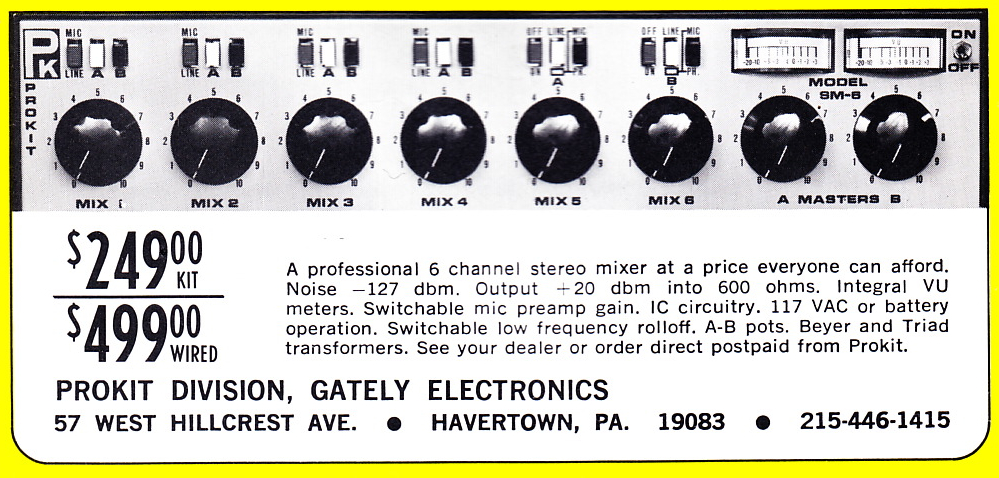

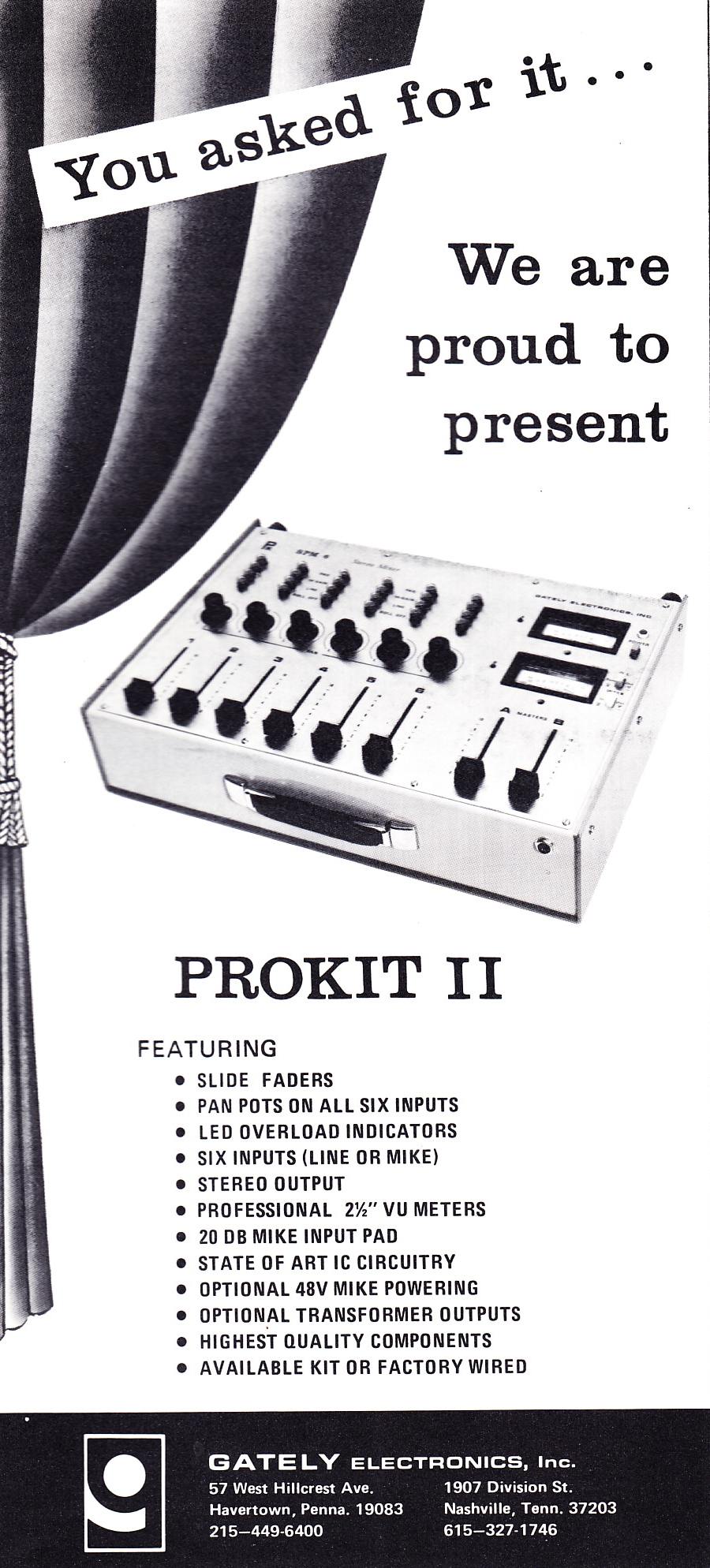
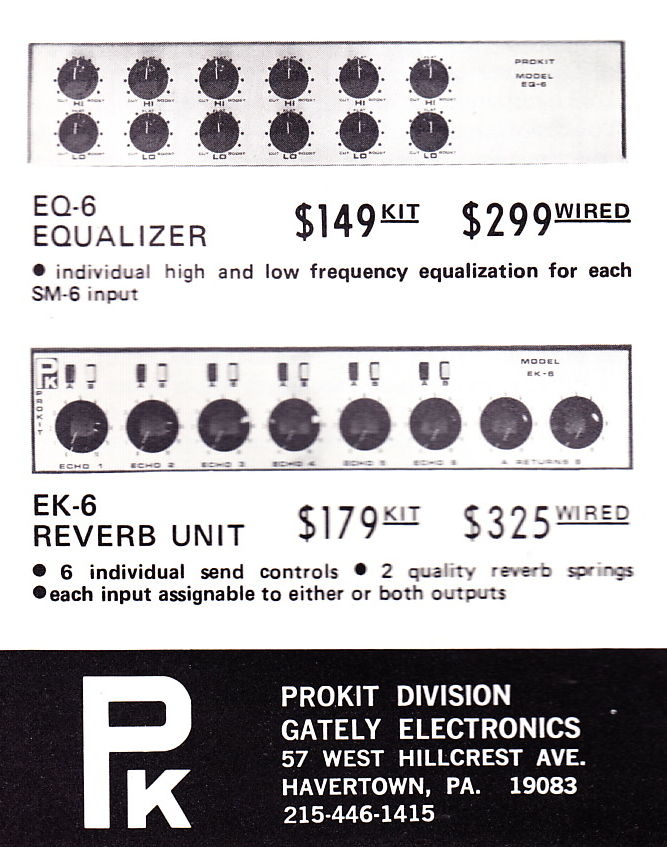
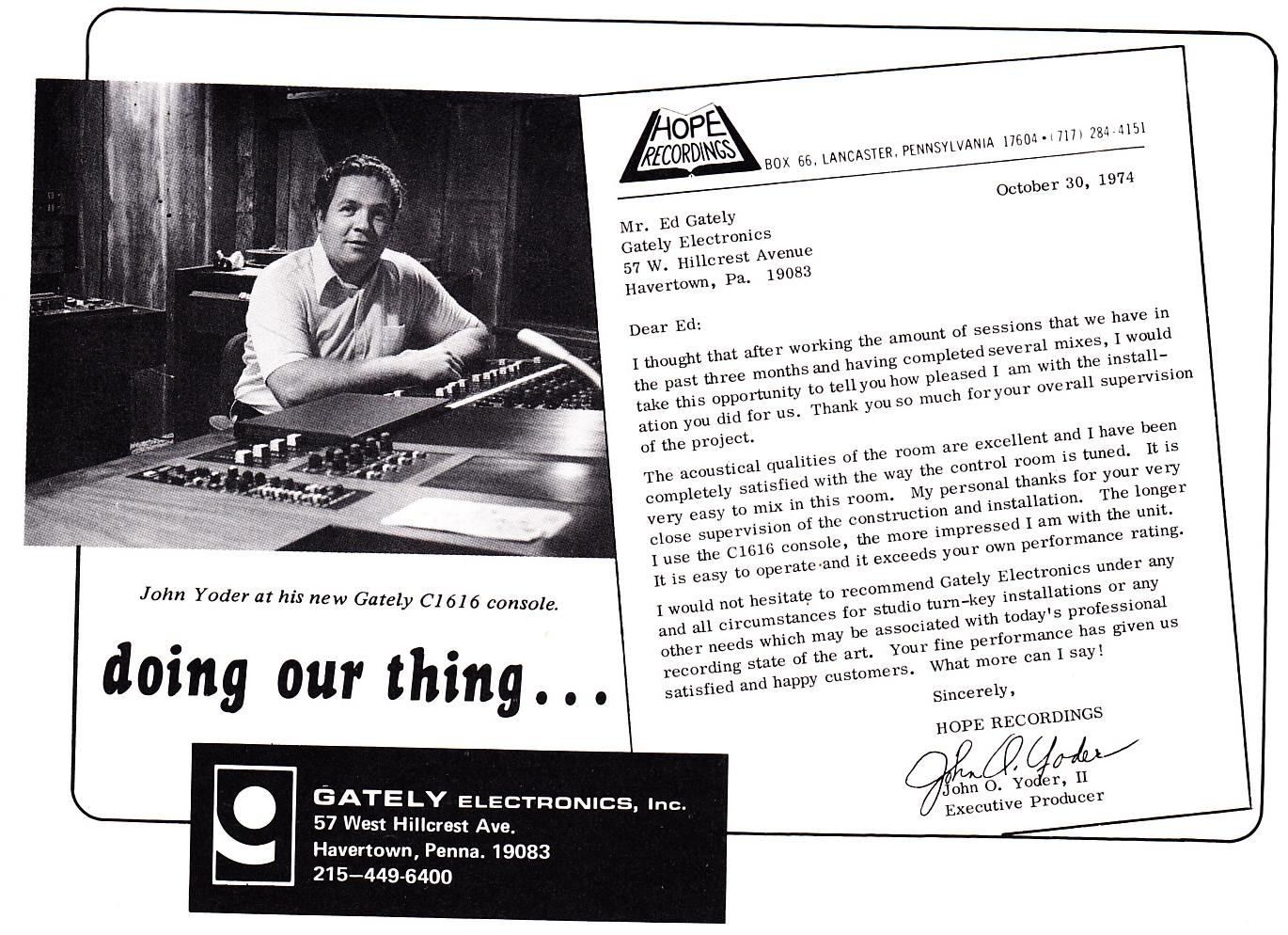
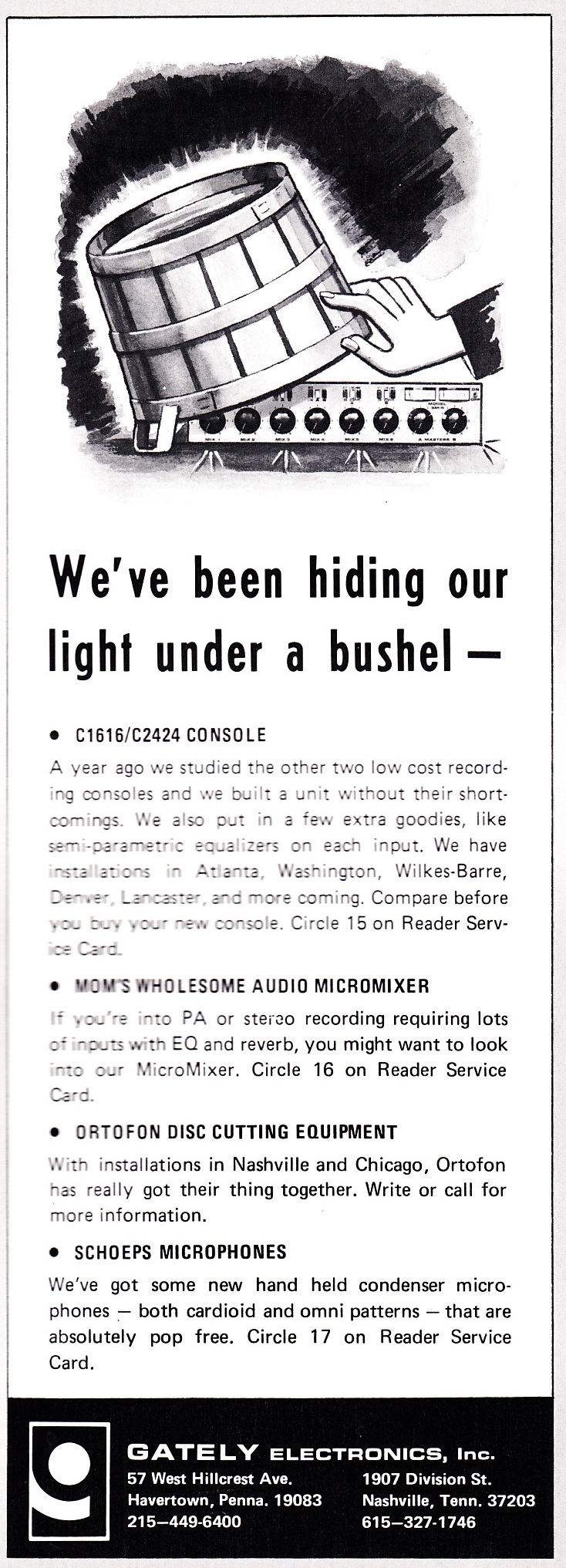
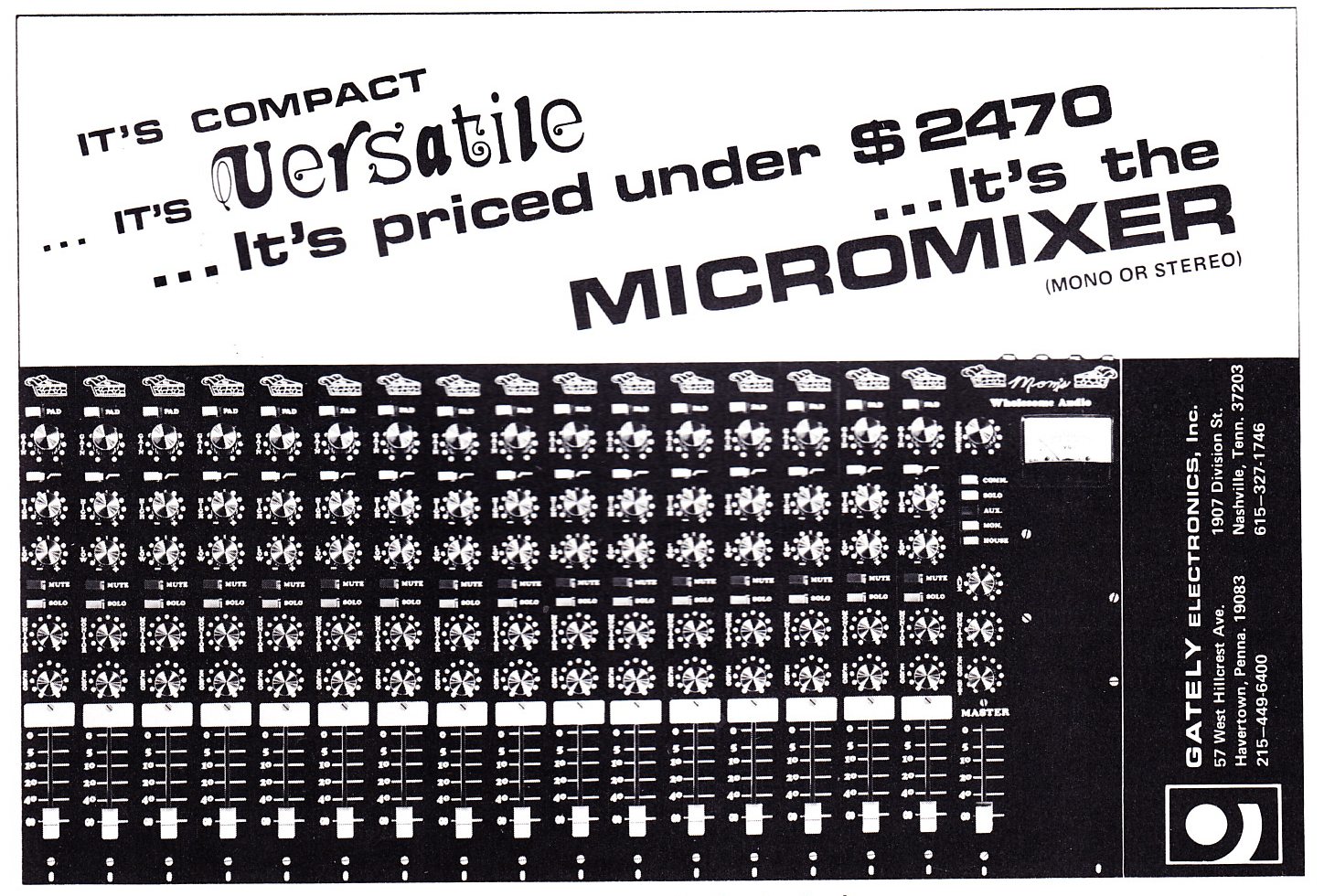
Above, from top to bottom: Gately ProKit 6-channel mixer (available as kit or assembled!), Gately’s Moms Wholesome Audio live PA board, Gately ProKit 2 mixer, and Gately EQ-6 and EK-6 equalizer and reverb accessories for the Pro-Kit (confused yet?). Below that, John Yoder of Hope Recordings recommends the Gately C1616 studio console. Next is an advert announcing Gately’s distribution of Ortofon lathes and Schoeps mics (yes please). Finally we see the Gately Micromixer, which appears to perhaps be the same as Moms Wholesome Audio Mixer?
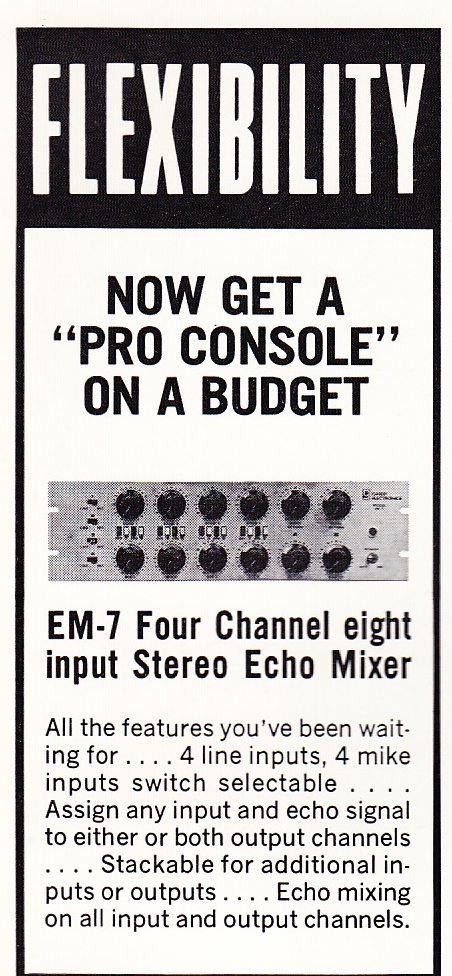
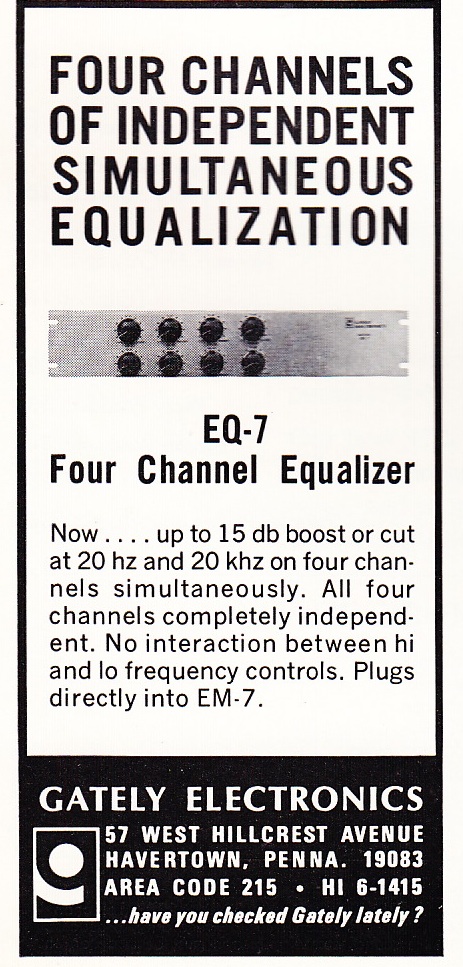
*****************************************************************
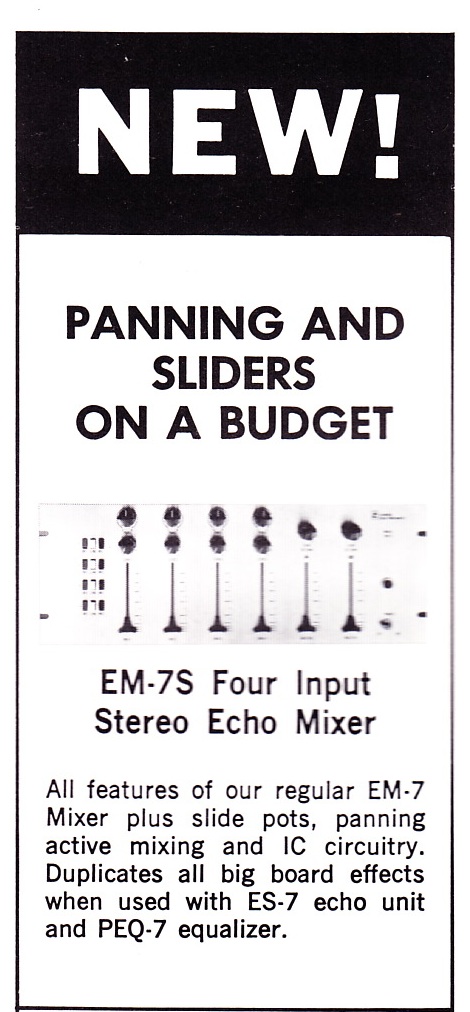
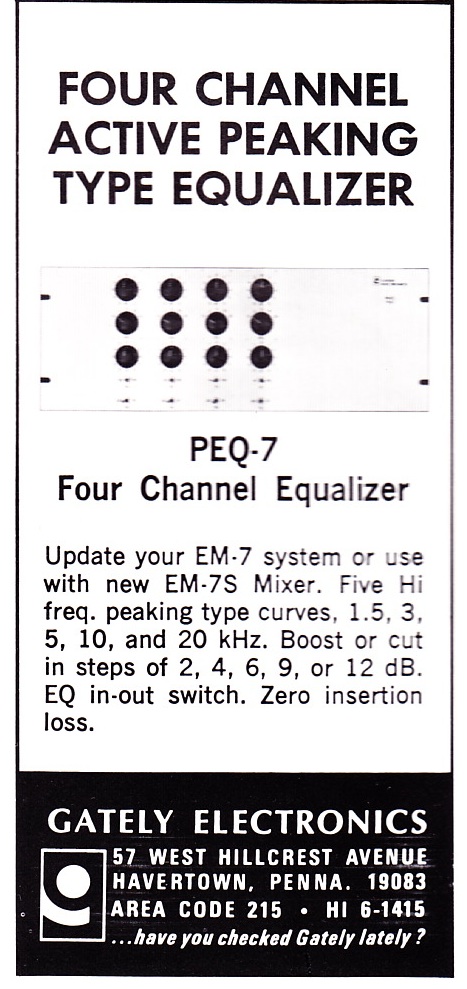
***********************************************************************
Above: the Gately EM7 and EQ7, as described in my earlier article, followed by the subsequent updated versions EM7s and PEQ7. The PEQ7 seems to have exchanged th fixed hi-shelf control of the EQ7 for a five-frequency high bell curve EQ. Low frequency control is presumably still a shelf-type. I can’t find any other info on the ES-7 echo unit.
In 1974 a writer from DB (I imagine Woram or Zide; no credit is indicated) traveled to Gately’s Philadelphia-area facility.
You can download the account of their trip at this link: Gately_DB_Feb74
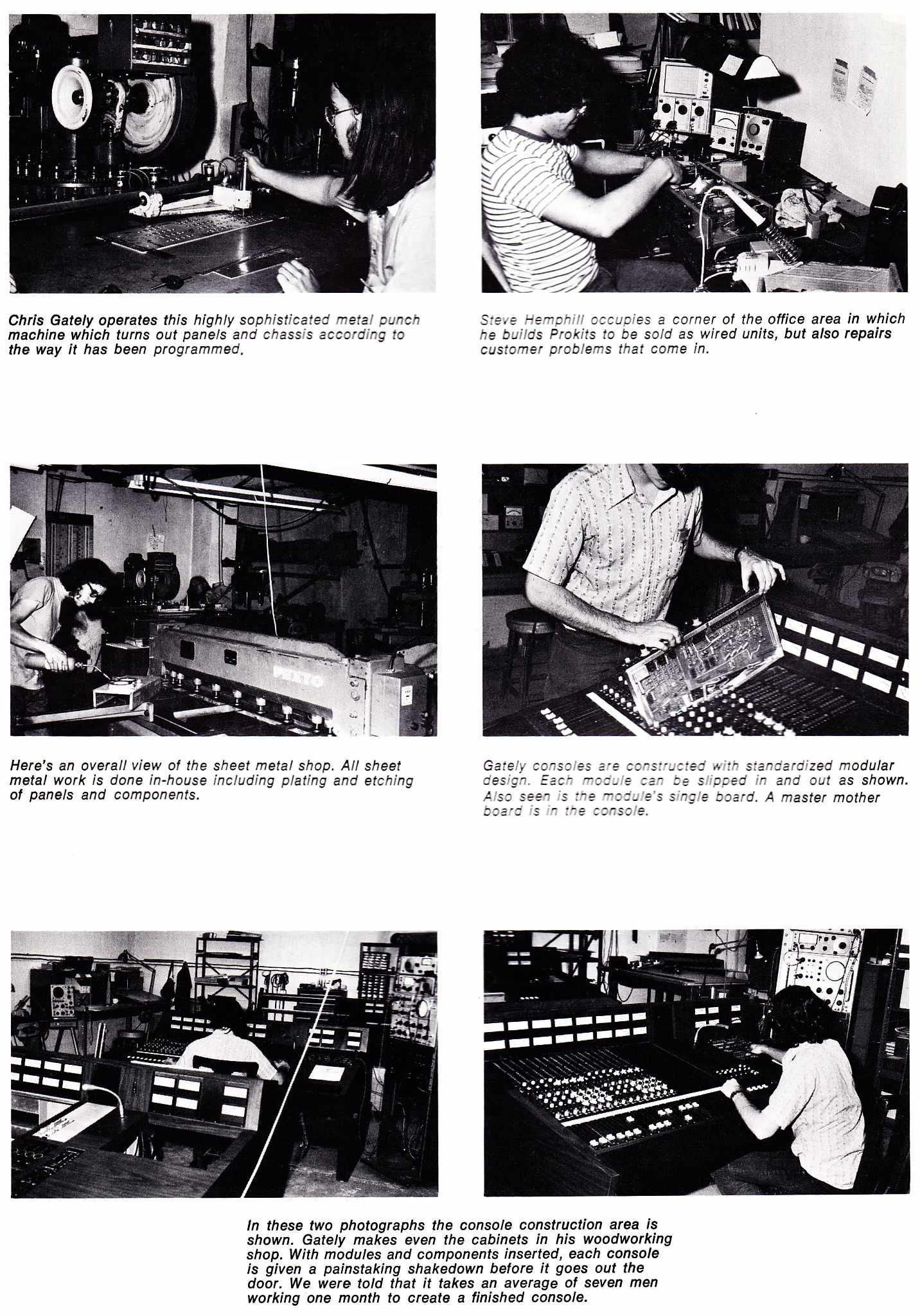
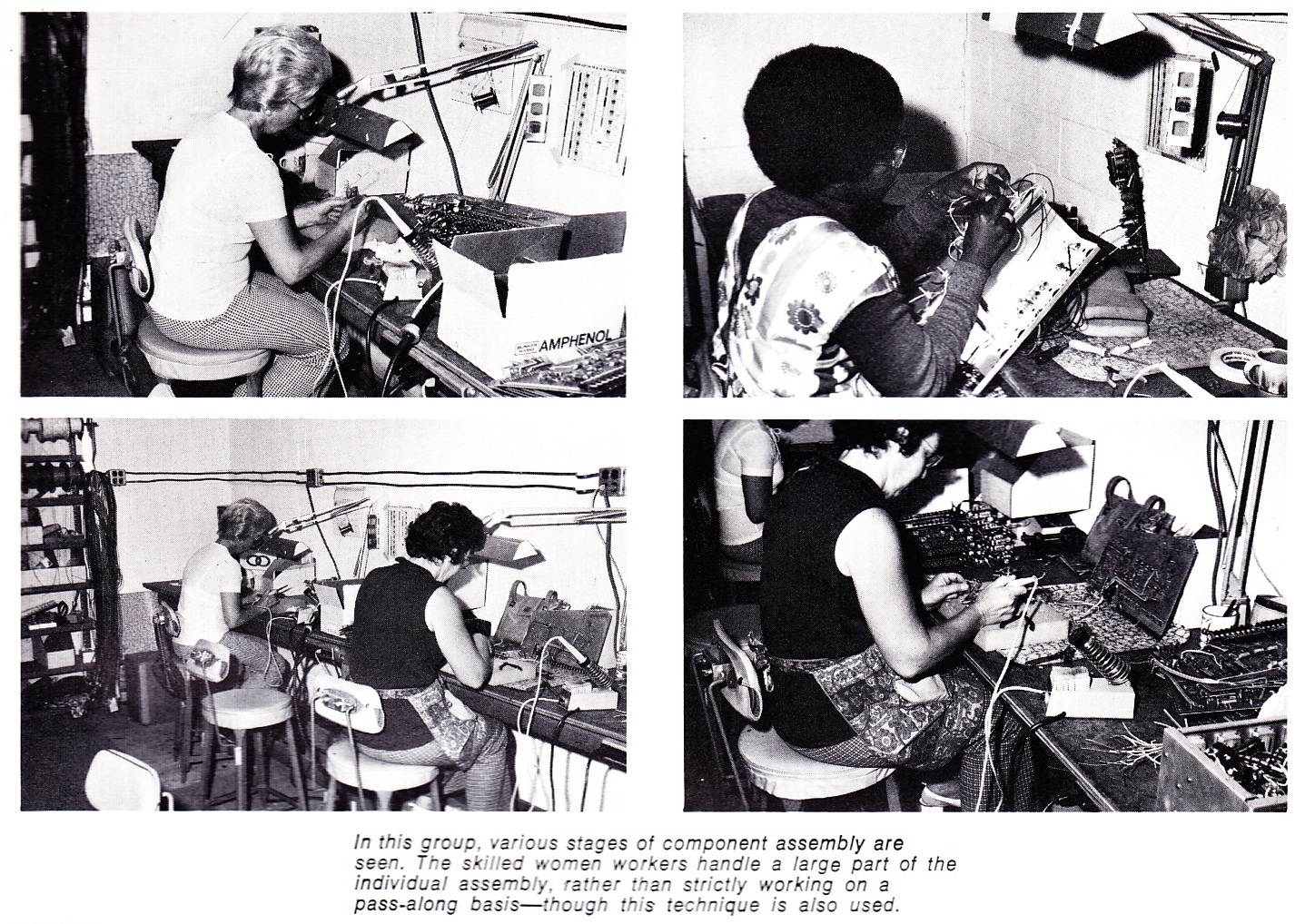 If there are any Gately alums out there, drop us a line; and if anyone out there is using any of this Gately kit, please let us know your thoughts. I have yet to use my EM7 and EQ7 on a production, but at some point I hope to be able to do a shoot-out versus some better-known contemporary units such as API and Neve.
If there are any Gately alums out there, drop us a line; and if anyone out there is using any of this Gately kit, please let us know your thoughts. I have yet to use my EM7 and EQ7 on a production, but at some point I hope to be able to do a shoot-out versus some better-known contemporary units such as API and Neve.
*************
*******
***
From PS dot com reader J. Roberts:
“I have a Gately Prokit II that I bought from Bob Todrank back around 1976. Bob had one of the first audio businesses in Berry Hill.
The mixer still works, no repairs ever, factory wired, I think it may be something like serial # 101w, but I will have to look and see. I kept a search on ebay for Gately and finally something surfaced… an original manual for my mixer.
I like that mixer because it is simple, no eq or anything to mess up, just set levels and pan. Interesting that the headphone out has no volume control, but I bought an old pair of Koss with faders just to use with that mixer. It looks to have very high quality components. I do not know about ICs, wondering if the ones in there are ok or should be upgraded. Does not have the output transformer option either. In a day or two I plan to feed a Coopersound micpre into the line ins and see what I get. I guess I should lay down some tracks and make another classical guitar LP, as I did back around 1978. Mastered at NRP by Larry Boden. Very fun times.”
What’s New in the most advanced equalizers Archives?
Screen Shot

System Requirements for Most advanced equalizers Archives
- First, download the Most advanced equalizers Archives
-
You can download its setup from given links:


